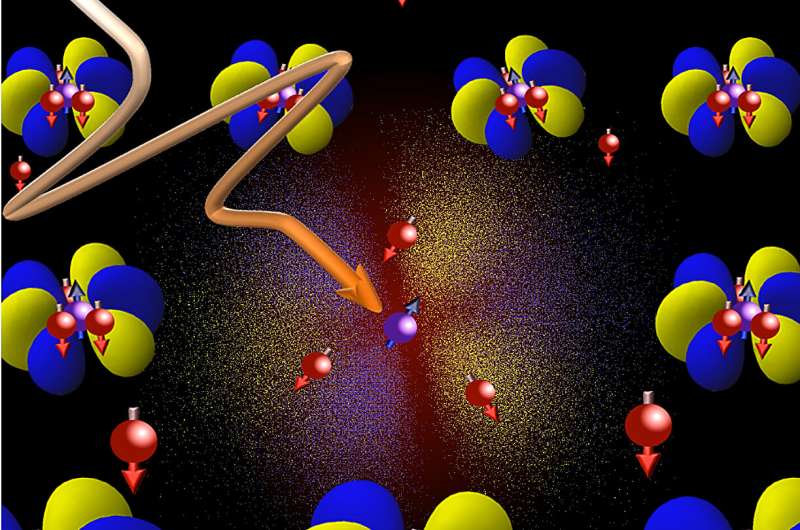When electrons slowly vanish during cooling: Researchers observe an effect unique to the quantum world

Many substances change their properties when they are cooled below a certain critical temperature. Such a phase transition occurs, for example, when water freezes. However, in certain metals there are phase transitions that do not exist in the macrocosm. They arise because of the special laws of quantum mechanics that apply in the realm of nature’s smallest building blocks.
It is thought that the concept of electrons as carriers of quantized electric charge no longer applies near these exotic phase transitions. Researchers at the University of Bonn and ETH Zurich have now found a way to prove this directly. Their findings allow new insights into the exotic world of quantum physics. The publication has now been released in the journal Nature Physics.
If you cool water below zero degrees Celsius, it solidifies into ice. In the process, it abruptly changes its properties. As ice, for example, it has a much lower density than in a liquid state—which is why icebergs float. In physics, this is referred to as a phase transition.
But there are also phase transitions in which characteristic features of a substance change gradually. If, for example, an iron magnet is heated up to 760 degrees Celsius, it loses its attraction to other pieces of metal—it is then no longer ferromagnetic, but paramagnetic. However, this does not happen abruptly, but continuously: The iron atoms behave like tiny magnets.
At low temperatures, they are oriented parallel to each other. When heated, they fluctuate more and more around this rest position until they are completely randomly aligned, and the material loses its magnetism completely. So while the metal is being heated, it can be both somewhat ferromagnetic and somewhat paramagnetic.
Matter particles cannot be destroyed
The phase transition thus takes place gradually, so to speak, until finally all the iron is paramagnetic. Along the way, the transition slows down more and more. This behavior is characteristic of all continuous phase transitions. “We call it ‘critical slowing down,'” explains Prof. Dr. Hans Kroha of the Bethe Center for Theoretical Physics at the University of Bonn. “The reason is that with continuous transitions, the two phases get energetically closer and closer together.”
It is similar to placing a ball on a ramp: It then rolls downhill, but the smaller the difference in altitude, the more slowly it rolls. When iron is heated, the energy difference between the phases decreases more and more, in part because the magnetization disappears progressively during the transition.
Such a “slowing down” is typical for phase transitions based on the excitation of bosons. Bosons are particles that “generate” interactions (on which, for example, magnetism is based). Matter, on the other hand, is not made up of bosons but of fermions. Electrons, for example, belong to the fermions.
Phase transitions are based on the fact that particles (or also the phenomena triggered by them) disappear. This means that the magnetism in iron becomes smaller and smaller as fewer atoms are aligned in parallel. “Fermions, however, cannot be destroyed due to fundamental laws of nature and therefore cannot disappear,” Kroha explains. “That’s why normally they are never involved in phase transitions.”
Electrons turn into quasi-particles
Electrons can be bound in atoms; they then have a fixed place which they cannot leave. Some electrons in metals, on the other hand, are freely mobile—which is why these metals can also conduct electricity. In certain exotic quantum materials, both varieties of electrons can form a superposition state. This produces what are known as quasiparticles.
They are, in a sense, immobile and mobile at the same time—a feature that is only possible in the quantum world. These quasiparticles—unlike “normal” electrons—can be destroyed during a phase transition. This means that the properties of a continuous phase transition can also be observed there, in particular, critical slowing down.
So far, this effect could be observed only indirectly in experiments. Researchers led by theoretical physicist Hans Kroha and Manfred Fiebig’s experimental group at ETH Zurich have now developed a new method, which allows direct identification of the collapse of quasiparticles at a phase transition, in particular the associated critical slowing down.
“This has enabled us to show for the first time directly that such a slowdown can also occur in fermions,” says Kroha, who is also a member of the Transdisciplinary Research Area “Matter” at the University of Bonn and the Cluster of Excellence “Matter and Light for Quantum Computing” of the German Research Foundation. The result contributes to a better understanding of phase transitions in the quantum world. On the long term, the findings might also be useful for applications in quantum information technology.
More information:
Critical slowing down near a magnetic quantum phase transition with fermionic breakdown, Nature Physics (2023). DOI: 10.1038/s41567-023-02156-7. www.nature.com/articles/s41567-023-02156-7
Citation:
When electrons slowly vanish during cooling: Researchers observe an effect unique to the quantum world (2023, July 31)
retrieved 31 July 2023
from https://phys.org/news/2023-07-electrons-slowly-cooling-effect-unique.html
This document is subject to copyright. Apart from any fair dealing for the purpose of private study or research, no
part may be reproduced without the written permission. The content is provided for information purposes only.
For all the latest Science News Click Here
For the latest news and updates, follow us on Google News.

